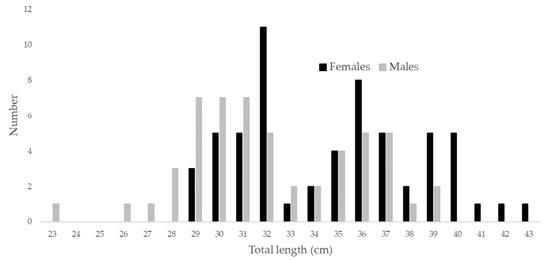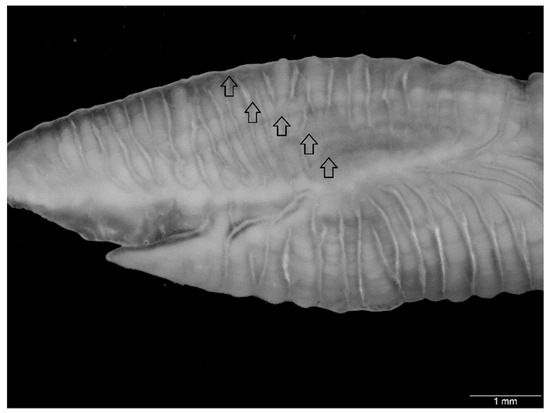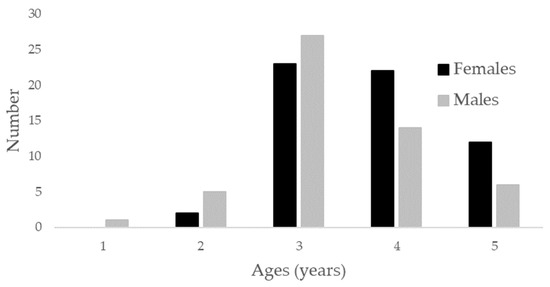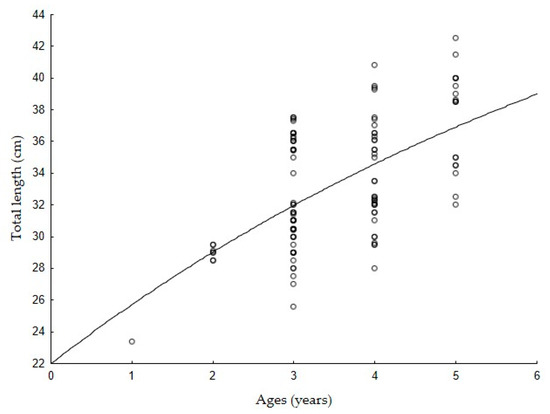Abstract
Age and growth of the European barracuda, Sphyraena sphyraena, were determined by examining sagittal otoliths belonging to fish sampled in the eastern Adriatic Sea, as the northernmost region of the Mediterranean. A total of 113 specimens (59 females, 53 males, and one individual of indeterminate sex), ranging from 23.4 to 42.5 cm in total length, were analyzed. The maximum observed age was 5 years for both females and males, and this barracuda population was dominated by 3 year old fish. Growth was described by the von Bertalanffy growth curve (L∞ = 55.58 cm, K = 0.12 year−1, t0 = −4.29 year, R2 = 0.580), and the growth performance index (Φ’) was 2.57. Otolith length, width, and mass were measured, and the utility of these morphometrics as predictors of age in S. sphyraena was evaluated. The results showed that counting otolith annuli produced a better estimation of age than proposed linear models based on relationships between observed fish age and otolith morphometrics. In comparison with age and growth data available in the literature for S. sphyraena, our results from the Adriatic Sea provide more insights into the life-history traits of this species and can be used in the future effective management and conservation.
1. Introduction
The family Sphyraenidae (barracudas), which is typically represented in shelf waters of tropical and temperate seas in many regions of the world, comprises only one genus, Sphyraena, and 28 species [1,2,3]. They are all active predatory and voracious fishes that can adapt to diverse ecological conditions [4,5]. Large adult barracudas are often found to be solitary, whereas juveniles and small adults are gregarious and aggregate to form schools [6]. In the Mediterranean, six Sphyraenidae species have been recorded so far: three Lessepsian (S. chrysotaenia Klunzinger, 1884; S. flavicauda Rüppell, 1838; S. obtusata Cuvier, 1829), two Atlanto-Mediterranean (S. sphyraena (Linnaeus, 1758); S. viridensis Cuvier, 1829), and one new species identified from the Gulf of Taranto (S. intermedia Pastore, 2009) [7,8].
The European barracuda, S. sphyraena, is a widespread species found in the eastern Atlantic (Bay of Biscay to Angola), including the Mediterranean and Black Sea, Canary Islands, and Azores [9]. It is a pelagic species living close to the surface [10], although individuals can be observed in a midwater, down to depths of 100 m [11]. In the Mediterranean, S. sphyraena is a specialized piscivore fish reaching 165 cm of the total length, while its size is usually between 30 and 50 cm [12]. This barracuda is a temperate species and generally shares habitats and resources with the thermophilic S. viridensis [5,12]. In comparison to other Sphyraenidae, only a few investigations have been carried out on the life-history traits of S. sphyraena. The growth [4,13], otolith shape analysis [8], reproductive biology [14], and feeding ecology [12] have been investigated in the southeastern Mediterranean. Otolith shape analysis has been also undertaken in the southwestern Mediterranean [7], and some patterns of reproductive biology have been reported in the northwestern part of the basin [5]. However, information regarding this barracuda species in the northernmost region of the Mediterranean (Adriatic Sea) has not yet been described in detail.
This study is the first attempt to investigate the age and growth of the eastern Adriatic population of the European barracuda; therefore, the aim is to provide better insight into the life-history of this species. Fish age was determined by counting annuli in sagittal otoliths; however, because this is one of the most time-consuming aging methods, we also evaluated the utility of otolith morphometrics (length, width, and mass) as an alternative.
2. Materials and Methods
2.1. Sampling
Samples of the European barracuda were obtained monthly from the local fish market between November 2020 and February 2021 and belonged to catches taken by purse and boat seiners in the central eastern Adriatic Sea during that period. Each fish was measured to the nearest 0.1 cm total length (TL) and weighed (W) to the nearest 0.1 g. Sex was determined by macroscopic analysis of the gonads, and sagittal otolith pairs were removed, cleaned, and stored dry in labeled Eppendorf tubes for later analyses. Sex ratio was tested for equality (female to male = 1:1) using the chi-square goodness-of-fit test at the 0.05 significance level. Length frequency distributions of females and males were compared using the Kolmogorov–Smirnov two-sample test.
2.2. Otolith Morphometrics
Prior to polishing, otoliths were photographed using an Olympus DP-25 digital camera (Olympus Corporation, Hamburg, Germany) attached to an Olympus SZX10 stereo microscope. Otolith length (OL) and width (OW) were measured to the nearest 0.01 mm using Olympus Cell^A Imaging Software, version 2.6 (Build 1210). Otolith length was defined as the longest axis between anterior and posterior otolith edge, and width was defined as the distance from dorsal to ventral edge taken perpendicular to the length throughout the otolith focus. Otolith mass (OM) was weighed to the nearest 0.0001 g. Differences between left and right otoliths were tested by paired t-test, while ANCOVA was used to test for differences in otolith measures between females and males, considering fish length as a covariate. The statistical assumptions of these tests were tested using the Kolmogorov–Smirnov test of normality, and, when necessary, data were log-transformed. Relationships between fish total length and otolith morphometrics (length, width, and mass) were constructed using the linear model.
2.3. Age and Growth Estimation
The medial face of a single, randomly selected otolith from each pair was polished using a wet abrasive paper and photographed under reflected light against a dark background, using a stereo microscope coupled with an Olympus DP-25 digital camera. Growth rings were visible as alternating opaque and translucent zones, and ages were assigned to fish specimens on the basis of their counts. Therefore, one opaque zone combined with one subsequent translucent zone was interpreted as one annulus, as already observed in Sphyraena species [2,15]. Each otolith was read by one reader, without auxiliary data on the fish size. A second reading was carried out 1 week later, and, when readings differed by one or more years, a third reading was made. We used images for the age estimation because their quality and ability to adjust contrast and brightness made it easier to interpret zoning patterns than direct observations under the stereo microscope.
The von Bertalanffy growth model was fitted to the estimated age–length dataset using a nonlinear least-square procedure of a Gauss–Newton algorithm: TL = L∞ (1 − exp(−K(t − t0))), where TL is the total length of fish at age t, L∞ is the estimated asymptotic length, K is a constant that determines the rate at which TL approaches L∞, and t0 is the hypothetical age at zero length. To compare the fish within the genus Sphyraena, the index Φ’ was calculated as follows: Φ’ = 2 log L∞ + log K, where Φ’ is the growth performance of fish, L∞ is the asymptotic length derived from the von Bertalanffy growth model, and K is the growth constant also derived from the von Bertalanffy growth model [16]. Once the age was estimated by counting annual growth rings, relationships between observed fish age and otolith morphometrics (length, width, and mass) were constructed using the linear model.
3. Results
Of the 113 individuals of the European barracuda sampled, 59 (52.2%) were females, 53 (46.9%) were males, and one (0.9%) individual was of indeterminate sex. The sex ratio was not significantly skewed toward females or males (p = 0.57). The total length of females and males ranged from 28.5 to 42.5 cm and from 23.4 to 38.6 cm, respectively (Table 1). A higher proportion of males were smaller than females. Males dominated in the ≤31.0 cm length classes, whereas females were more abundant in the ≥36.0 cm length classes (Figure 1). The Kolmogorov–Smirnov two-sample test showed a significant difference between length frequency distributions of females and males (p < 0.01). The mean length of females (34.6 ± 3.75 cm) was significantly greater than that of males (32.0 ± 3.56 cm) (t-test, df = 1, p < 0.01).

Table 1.
Range of total length and weight and mean total length and weight with standard deviation (SD) of the European barracuda, Sphyraena sphyraena, in the eastern Adriatic.

Figure 1.
Length frequency distributions of the European barracuda, Sphyraena sphyraena, females and males in the eastern Adriatic.
Otoliths of S. sphyraena are spindle-shaped, with a short rostrum and poorly defined antirostrum. Their anterior region is peaked, while the posterior is oblique. No significant differences in morphometric measures (length, width, and mass) were found between left and right otoliths (paired t-test, p > 0.05 for all measures) and between females and males (ANCOVA, p > 0.05 for all measures); thus, data were pooled for both sexes, and mean values for each otolith pair were used in further analyses (Table 2). A linear model described relationships between fish total length and otolith length, width, and mass, with high coefficients of determination (≥0.805) (Table 3).

Table 2.
Range of otolith measures (OL = otolith length, OW = otolith width, OM = otolith mass) and their mean values with standard deviation (SD) of the European barracuda, Sphyraena sphyraena, in the eastern Adriatic.

Table 3.
Parameters of the linear regression between fish total length (TL) and otolith morphometrics (OL = otolith length, OW = otolith width, OM = otolith mass) of the European barracuda, Sphyraena sphyraena, in the eastern Adriatic (a = intercept value; b = regression slope; R2 = coefficient of determination).
Sagittal otoliths displayed alternating opaque and translucent zones under reflected light (Figure 2). The maximum age of the sampled European barracuda was 5 years for both females and males (Figure 3). Age distribution was similar for both sexes and was skewed to the right. The population was dominated by 3 year old fish, which represented almost 45% of the fish sampled. Fish younger than 3 years were poorly represented (we found only one 1 year old individual). Mean lengths (±standard deviation) of 1, 2, 3, 4, and 5 year old fish were 23.4 cm, 29.0 ± 0.41 cm, 32.4 ± 3.27 cm, 33.9 ± 3.29 cm, and 37.5 ± 3.15 cm, respectively. Females were larger than males at all ages. The von Bertalanffy growth curve was fitted to the age–length dataset estimated for all specimens (Figure 4). Estimated parameters were L∞ = 55.58 cm, K = 0.12 year−1, and t0 = −4.29 year (R2 = 0.580). The growth performance index (Φ’) was 2.57 for the sampled fish. Relationships between observed fish age and otolith morphometrics are presented in Table 4. The linear model explained between 23.6% and 27.7% of the variation in age.

Figure 2.
Sagittal otolith of the 5 year old European barracuda, Sphyraena sphyraena, in the eastern Adriatic.

Figure 3.
Age distributions of the European barracuda, Sphyraena sphyraena, females and males in the eastern Adriatic.

Figure 4.
Fitted von Bertalanffy growth curve of the European barracuda, Sphyraena sphyraena, in the eastern Adriatic.

Table 4.
Relationships between observed fish age and otolith morphometrics (OL = otolith length, OW = otolith width, OM = otolith mass) of the European barracuda, Sphyraena sphyraena, in the eastern Adriatic, described using the linear model (age = a (otolith morphometric) + b); R2 = coefficient of determination.
4. Discussion
Despite its wide distribution, studies concerning the age of S. sphyraena are currently available only for the southeastern Mediterranean populations (Egyptian waters) [4,13]. The maximum age estimated in our study using whole otolith readings (5 years) was lower than the maximum age demonstrated by Allam et al. [13] (8 years) using the same method and a similar length range. However, only 4% of the specimens collected in Egyptian waters were older than 5 years [13]. On the other hand, our age readings were higher than those reported in another available study (3 years) [4]. The most striking difference in the life span of S. sphyraena seems to occur among populations from the same area. As far as growth parameters are concerned, there was good agreement, and parameters estimated in our study were very similar to the only available growth data on this species for Egyptian waters: L∞ = 55.27 cm and K = 0.123 year−1 [13]. This similarity may be attributable to the dominance of individuals in the same age classes in both populations, in conjunction with the already mentioned small proportion of the oldest individuals (>5 years) in Egyptian waters. In addition, the growth increments for both populations were greatest in the first 2 years. All observed similarities were also reflected in almost the same values for Φ’: 2.57 and 2.58 [13] for the northern and southeastern Mediterranean populations, respectively. The low estimate of t0 can be explained by the few fish ≤28.0 cm and a complete absence of the fish <23.0 cm in our samples. In fact, if smaller fish were sampled in both areas, t0 would have been higher and closer to 0. Consequently, the population age structure shows a lack of fish in the first two age classes, principally due to accessibility to the resources on the fish market. Although females and males showed differences in growth, as females were larger than males at all ages sampled, we acknowledge that our study is not conclusive about possible differences in growth between sexes. More data, particularly from smaller and younger fish, would improve estimates and ensure modeling for S. sphyraena females and males separately. However, although the sample size was relatively small for young individuals, the sample covered a wide length and age range; thus, the results of this study are still reliable and valuable. By producing such preliminary growth estimates for S. sphyraena in the studied area, we take an important step toward facilitating future studies and management strategies.
The index of growth performance is a useful tool for comparing the growth curves of different populations of the same species and of different species belonging to the same genus or family [17]. Calculated from published data of L∞ and K in Mediterranean Sphyraena species, the values of this index were the highest in S. viridensis (2.95 in Egyptian waters [13] and 3.33 in Algerian waters [15]) and the lowest in S. chrysotaenia (2.46 [13] and 2.62 [2] in Egyptian waters). In S. flavicauda from Egyptian waters, recorded values were 2.77 [13] and 2.82 [2]. These variations could be attributed to environmental conditions affecting distribution, population structure, and growth patterns [18]. The obtained Φ’ value in this study was within the range of values for different Sphyraena species in the Mediterranean (2.46 < Φ’ < 3.33). In general, growth studies providing the von Bertalanffy growth parameters for other Sphyraena species are scarce, and the main point of reference is represented by data provided for the southeastern Mediterranean populations.
Interpreting annual growth rings in otoliths, as in this study, is the most frequently used method for estimating individual fish age [19]. On the other hand, it has several disadvantages; it is subjective, laborious, time-consuming, and dependent on the readers’ experience [20]. In that context, several studies have analyzed and demonstrated a close relationship between the size of the otoliths and fish age [20,21,22,23,24,25]. A linear model described all relationships between otolith measures and fish age, and the age of the investigated barracuda could be best predicted from the otolith length. However, we must emphasize that models did not provide precise estimates, and this could be explained by the overlap in lengths between fish of different age (especially in the age classes 3 and 4) and a lack of the fish in the first two age classes. Despite that, the observed otolith morphology of S. sphyraena generally corresponded to descriptions for this species from the eastern Atlantic and Mediterranean [7,8,26], and it can be used in the identification of species (e.g., in feeding studies or species separation within Sphyraena genus).
5. Conclusions
This study provides the first analysis of European barracuda age and growth in the northernmost region of the Mediterranean. We showed that otoliths can be used for aging, and our estimates of growth seems reasonable for a species with a moderate life span. Counting otolith annuli produced better estimation of age than proposed linear models based on relationships between observed fish age and otolith morphometrics. However, these preliminary results should be used with caution, and further studies with larger sample sizes collected throughout the year are required to refine the age and growth information for S. sphyraena in the Adriatic. Similar studies are, therefore, encouraged within the Mediterranean to achieve a more comprehensive understanding of the life-history traits of this temperate fish species.
Author Contributions
Conceptualization, J.F.; methodology, J.F.; software, J.F.; validation, J.F. and A.B.; formal analysis, J.F. and A.B.; investigation, J.F. and A.B.; resources, J.F. and A.B.; data curation, J.F.; writing—original draft preparation, J.F.; writing—review and editing, J.F.; visualization, J.F.; supervision, J.F. All authors read and agreed to the published version of the manuscript.
Funding
This research received no external funding.
Institutional Review Board Statement
The study was conducted according to the guidelines of the Code of Ethics of the University Department of Marine Studies; we only used specimens obtained from the fish market that were already dead.
Data Availability Statement
Data from this study are available from the corresponding author upon request (J.F.: josipa.ferri@unist.hr).
Conflicts of Interest
The authors declare no conflict of interest.
References
- Nelson, J.S.; Grande, T.C.; Wilson, M.V.H. Fishes of the World, 5th ed.; Wiley: Hoboken, NJ, USA, 2016; pp. 468–472. [Google Scholar]
- ElGanainy, A.; Amin, A.; Ali, A.; Osman, H. Age and growth of two barracuda species Sphyraena chrysotaenia and S. flavicauda (Family: Sphyraenidae) from the Gulf of Suez, Egypt. Egypt. J. Aquat. Res. 2017, 43, 75–81. [Google Scholar] [CrossRef] [Green Version]
- Ballen, G.A. Nomenclature of the Sphyraenidae (Teleostei: Carangaria): A synthesis of fossil- and extant-based classification systems. Zootaxa 2019, 4686, 397–408. [Google Scholar] [CrossRef] [PubMed]
- Wadie, W.F.; Rizkalla, S.I. Fisheries for the genus Sphyraena (Perciformes, Sphyraenidae) in the south-eastern part of the Mediterranean Sea. Pak. J. Mar. Sci. 2001, 10, 21–34. [Google Scholar]
- Villegas-Hernández, H.; Muñoz, M.; Lloret, J. Life-history traits of temperate and thermophilic barracudas (Teleostei: Sphyraenidae) in the context of sea warming in the Mediterranean Sea. J. Fish Biol. 2014, 84, 1940–1957. [Google Scholar] [CrossRef] [PubMed]
- Pastore, A. Sphyraena intermedia sp. nov. (Pisces: Sphyraenidae): A potential new species of barracuda identified from the central Mediterranean Sea. J. Mar. Biol. Assoc. 2009, 89, 1299–1303. [Google Scholar] [CrossRef]
- Bourehail, N.; Morat, F.; Lecomte-Finiger, R.; Kara, M.H. Using otolith shape analysis to distinguish barracudas Sphyraena sphyraena and Sphyraena viridensis from the Algerian coast. Cybium 2015, 39, 271–278. [Google Scholar]
- Yedier, S. Otolith shape analysis and relationships between total length and otolith dimensions of European barracuda, Sphyraena sphyraena in the Mediterranean Sea. Iran. J. Fish. Sci. 2021, 20, 1080–1096. [Google Scholar]
- Froese, R.; Pauly, D. FishBase. World Wide Web Electronic Publication. Version (08/2021). Available online: www.fishbase.org (accessed on 10 January 2022).
- Golani, D.; Öztürk, B.; Başusta, N. The Fishes of Eastern Mediterranean; Turkish Marine Research Foundation: Istanbul, Turkey, 2006; pp. 179–181. [Google Scholar]
- Ben-Tuvia, A. Sphyraenidae. In Fishes of the North-Eastern Atlantic and the Mediterranean; Whitehead, P.J.P., Bauchot, M.L., Hureau, J.C., Nielsen, J., Tortonese, E., Eds.; UNESCO: Paris, France, 1986; pp. 1194–1196. [Google Scholar]
- Kalogirou, S.; Mittermayer, F.; Pihl, L.; Wennhage, H. Feeding ecology of indigenous and non-indigenous fish species within the family Sphyraenidae. J. Fish Biol. 2012, 80, 2528–2548. [Google Scholar] [CrossRef] [PubMed]
- Allam, S.M.; Faltas, S.N.; Ragheb, E. Age and growth of barracudas in the Egyptian Mediterranean waters. Egypt. J. Aquat. Res. 2004, 30, 281–289. [Google Scholar]
- Allam, S.M.; Faltas, S.N.; Ragheb, E. Reproductive biology of Sphyraena species in the Egyptian Mediterranean waters of Alexandria. Egypt. J. Aquat. Res. 2004, 30, 255–270. [Google Scholar]
- Bourehail, N.; Kara, M.H. Age, growth and mortality of the yellowmouth barracuda Sphyraena viridensis (Sphyraenidae) from eastern coasts of Algeria. J. Mar. Biol. Assoc. 2021, 101, 599–608. [Google Scholar] [CrossRef]
- Munro, J.L.; Pauly, D. A simple method for comparing the growth of fishes and invertebrates. Fishbyte 1983, 1, 5–6. [Google Scholar]
- Sparre, P.; Ursin, E.; Venema, S.C. Introduction to Tropical Fish Stock Assessment. Part 1: Manual; FAO Fisheries Technical Paper; FAO: Rome, Italy, 1987; pp. 75–76. [Google Scholar]
- Wootton, R.J. Ecology of Teleost Fishes; Chapman and Hall: England, UK, 2012; pp. 117–158. [Google Scholar]
- Matić-Skoko, S.; Ferri, J.; Škeljo, F.; Bartulović, V.; Glavić, K.; Glamuzina, B. Age, growth and validation of otolith morphometrics as predictors of age in the forkbeard, Phycis phycis (Gadidae). Fish. Res. 2011, 112, 52–58. [Google Scholar] [CrossRef]
- Cardinale, M.; Arrhenius, F. Using otolith weight to estimate the age of haddock (Melanogrammus aeglefinus): A tree model application. J. Appl. Ichthyol. 2004, 20, 470–475. [Google Scholar] [CrossRef]
- Pilling, G.M.; Grandcourt, E.M.; Kirkwood, G.P. The utility of otolith weight as a predictor of age in the emperor Lethrinus mahsena and other tropical fish species. Fish. Res. 2003, 60, 493–506. [Google Scholar] [CrossRef]
- Pino, A.C.; Cubillos, L.A.; Araya, M.; Sepúlveda, A. Otolith weight as an estimator of age in the Patagonian grenadier, Macruronus magellanicus, in central-south Chile. Fish. Res. 2004, 66, 145–156. [Google Scholar] [CrossRef]
- Doering-Arjes, P.; Cardinale, M.; Mosegaard, H. Estimating population age structure using otolith morphometrics: A test with known-age Atlantic cod (Gadus morhua) individuals. Can. J. Fish. Aquat. Sci. 2008, 65, 2341–2350. [Google Scholar] [CrossRef]
- Steward, C.A.; DeMaria, K.D.; Shenker, J.M. Using otolith morphometrics to quickly and inexpensively predict age in the gray angelfish (Pomacanthus arcuatus). Fish. Res. 2009, 99, 123–129. [Google Scholar] [CrossRef]
- Škeljo, F.; Ferri, J.; Brčić, J.; Petrić, M.; Jardas, I. Age, growth and utility of otolith morphometrics as a predictor of age in the wrasse Coris julis (Labridae) from the eastern Adriatic Sea. Sci. Mar. 2012, 76, 587–595. [Google Scholar] [CrossRef] [Green Version]
- Tuset, V.M.; Lombarte, A.; Assis, C.A. Otolith atlas for the western Mediterranean, north and central eastern Atlantic. Sci. Mar. 2008, 72, 7–198. [Google Scholar] [CrossRef]
Publisher’s Note: MDPI stays neutral with regard to jurisdictional claims in published maps and institutional affiliations. |
© 2022 by the authors. Licensee MDPI, Basel, Switzerland. This article is an open access article distributed under the terms and conditions of the Creative Commons Attribution (CC BY) license (https://creativecommons.org/licenses/by/4.0/).